- 30 August
- written by Cathy Taylor
Guided Walks in NZ: How Fit Should You Be to Join?
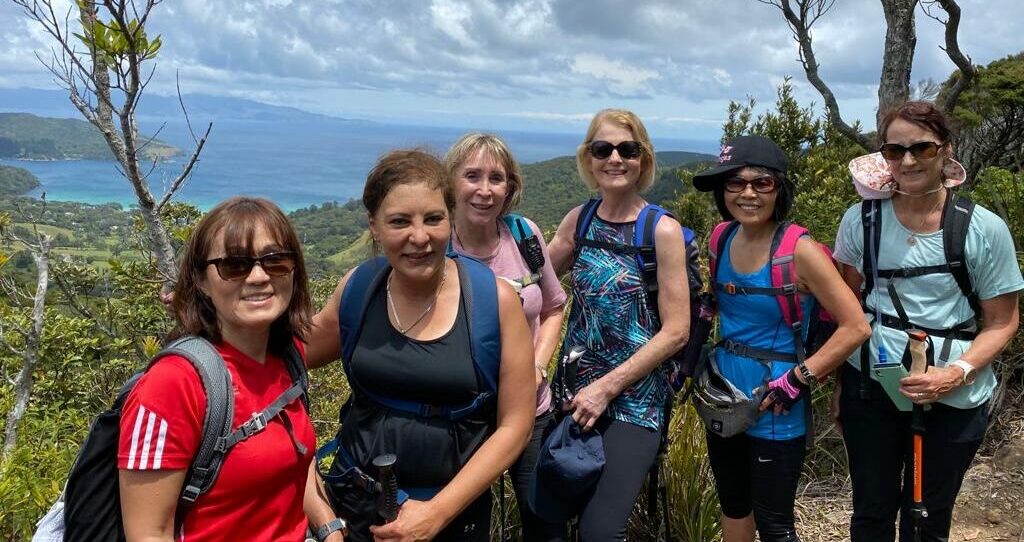
How Fit Do I Need To Be To Join A New Zealand Guided Hike?
Ah it’s the eternal question isn’t it? How fit do I need to be to join a guided multi-day walk in New Zealand? How do I know that I’m going to be able to keep up, avoid injuries and actually have a good time while I’m hiking?
Fitness is such a subjective thing. You and I might engage in the same level of activity at home, but when it comes to ‘trail fitness’ we may have very different abilities. Firstly we like to say, ‘the fitter you are, the more you’ll enjoy it.’ If you’re used to walking regularly, you’ll find yourself in a good starting position. You might like to add in some stair walking to your pre-departure training plan.
If you get around the golf course on a regular basis, this is also probably a good start. Test those ankles and knees on some harder terrain to see how they go.
How Hard Are The Walks in New Zealand?
We’ll be walking anywhere between 4 and 8 hours per day on a wide variety of tracks. We cover changeable terrain in all kinds of weather conditions. You carry just a day pack. No more than say, 3 – 5 kilograms depending on how much water you like to carry. If you’re not used to walking with a day pack, do a test-run near your home and adjust from there.
Our North Island guided walks are graded with a number between 1 and 5. Grade 1 trails are the absolute easiest hiking trails we could find. Grade 5 trails are gut-busting, advanced tramps for backcountry bush-bashers.
How Do We Know?
We’ve been guiding walking guests on our New Zealand hiking tours for over 20 years. We have the science of itinerary design down to a fine art. We’ve walked with every kind of hiker you could think of and we’ve seen it all! We know which trails are going to exhaust you and which ones are a merry jaunt. Our New Zealand guided walk itineraries are carefully arranged so that we’ll complete shorter, easier walks first. Then attacking those longer, harder hikes once we’re properly warmed up.
At Walking Legends our hiking comfort zone is within the ‘moderate’ hiking grade, or comfortably in the Level 3 and Level 4 area.
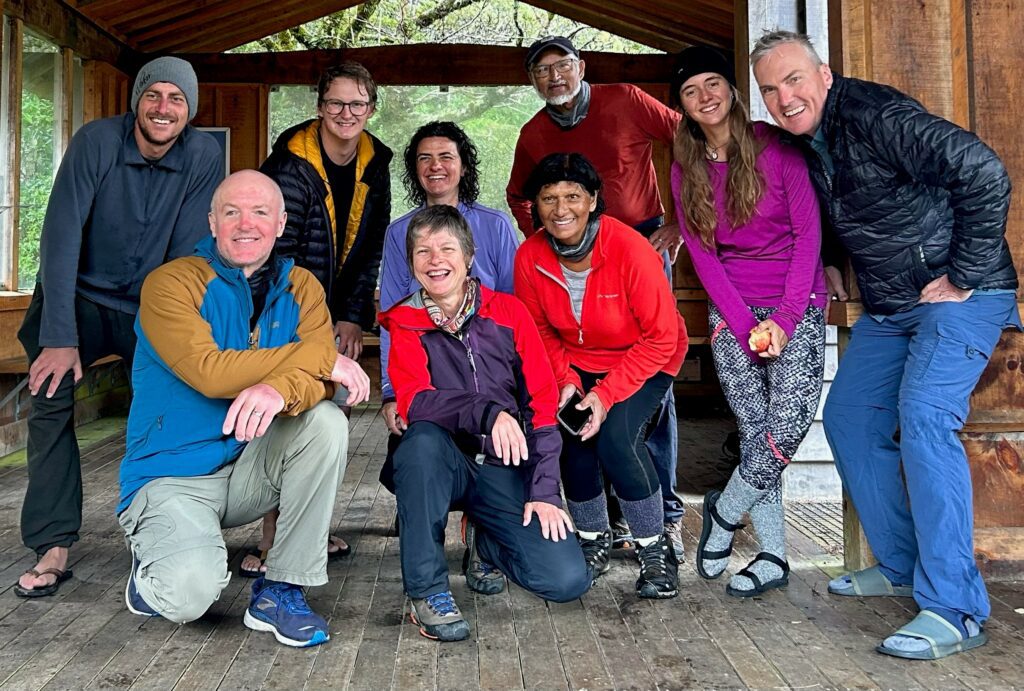
How Are New Zealand Hiking Trails Graded?
Most New Zealand hiking trails are graded by the Department of Conservation. You can check out their grading system on their website. Some outdoor companies or commercial operators run their own grading system. It’s quite confusing if this is your first time on a guided hike in New Zealand.
Hiking trails are not graded the same as mountain bike trails. The grading of a shared trail that might be part of the Ngā Haerenga / New Zealand Great Rides is not a good comparison. Here’s a handy guide so you can arrive for your North Island guided walk feeling prepared.
Level 1 – Easiest
A Level 1 hiking trail is easy. Expect very little elevation gain and the walk is likely to be less than 100 metres in length. The trail will be very well maintained underfoot, with few trip hazards. Any water crossings will be bridged and you’ll be able to do this walk in jandals (flip flops) or regular day shoes. Hiking boots or shoes won’t be absolutely necessary. There should be great drainage systems for surface water. There’s unlikely to be any boggy sections or mud of any kind. Parts of the trail may even be hard surface paving or asphalt.
The track will be really clearly marked. You may be able to see a significant distance ahead of you as there’ll be no ridges or valleys to negotiate. Public bathroom facilities are within each reach. Carparks are usually at the trail head, or positioned somewhere along the track. The track is probably also well-lit by street signs or overhead lighting for safety.
Where Can I Find The Easiest Hiking Tracks in New Zealand?
These kinds of hiking tracks are often located close to towns and cities. Ideally they are fully accessible for urbanites, families and just those walkers wanting to give the dog a good run around. Being close to built up areas you can also expect great mobile phone coverage and full service for the entire duration of the walk.
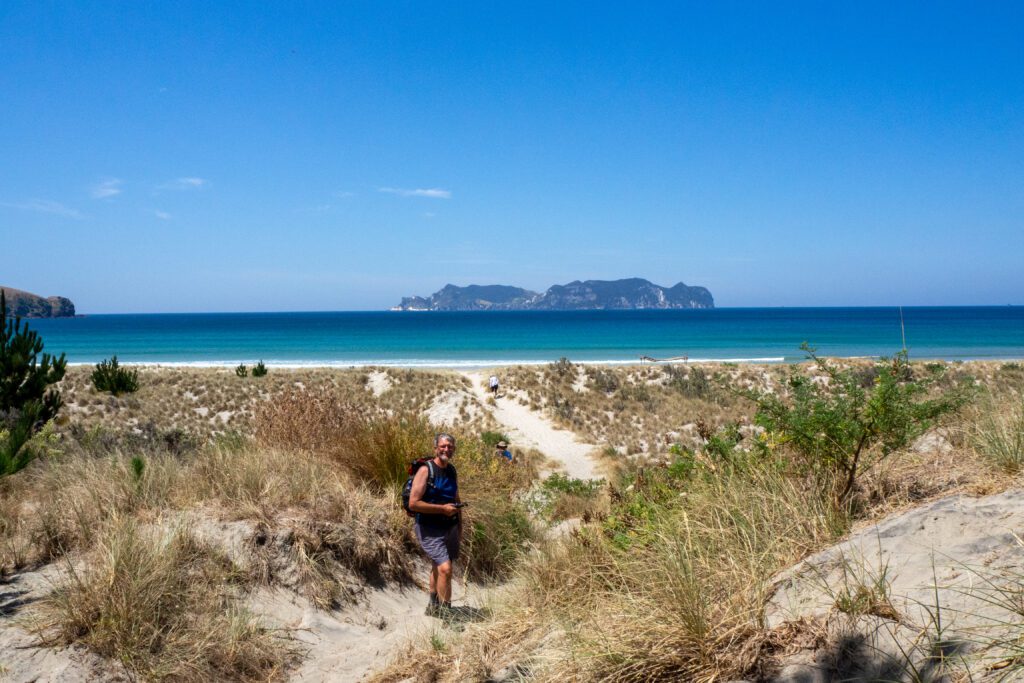
Level 2 – Easy
A Level 2 hiking trail is also considered easy. Like a Level 1 trail, there’ll be very little elevation gain but the terrain underfoot is likely to be just that little bit more uneven. It could be broken up with a few tree roots or a handful of small stairs. You might encounter small areas of surface water accumulation but nothing that isn’t passable.
Water crossings are still bridged and any staircases next to drop-offs are likely to have enclosed balustrading. A Level 2 trail will be clearly marked with orange triangles in the conventional New Zealand track marking style.
On a Level 2 trail we’re moving away from jandals and casual shoes and getting solid sneaker territory. You’ll definitely want to be wearing a sports shoe – not so much a hiking boot yet, but a outdoors specific sport shoe will stand you in good stead here.
Where Can I Find Level 2 Tracks in New Zealand?
You’ll see less public infrastructure on a Level 2 walk as you’ll likely to be further from a major centre. The nearest township might be 15 to 20-minutes drive away. There’s less chance of a public bathroom nearby as well, but possibly a pit-style, long-drop toilet if you’re lucky. You should have full mobile service on a Level 2 trail, but less street lighting. Consider taking a flashlight if you want to do the walk at dusk or early dawn.
Over the course of a 4-day guided walk with us, we’ll probably do 1, at a push maybe 2, Level 2 types of walks. Our purpose is to get you further out into the remote wilderness onto quieter trails where the big views and beautiful wildlife are abundant.
At the end of the Level 2 walk you’ll feel nicely warmed up and breathing slightly faster than normal. Nothing too strenuous if you’re used to regular physical activity.
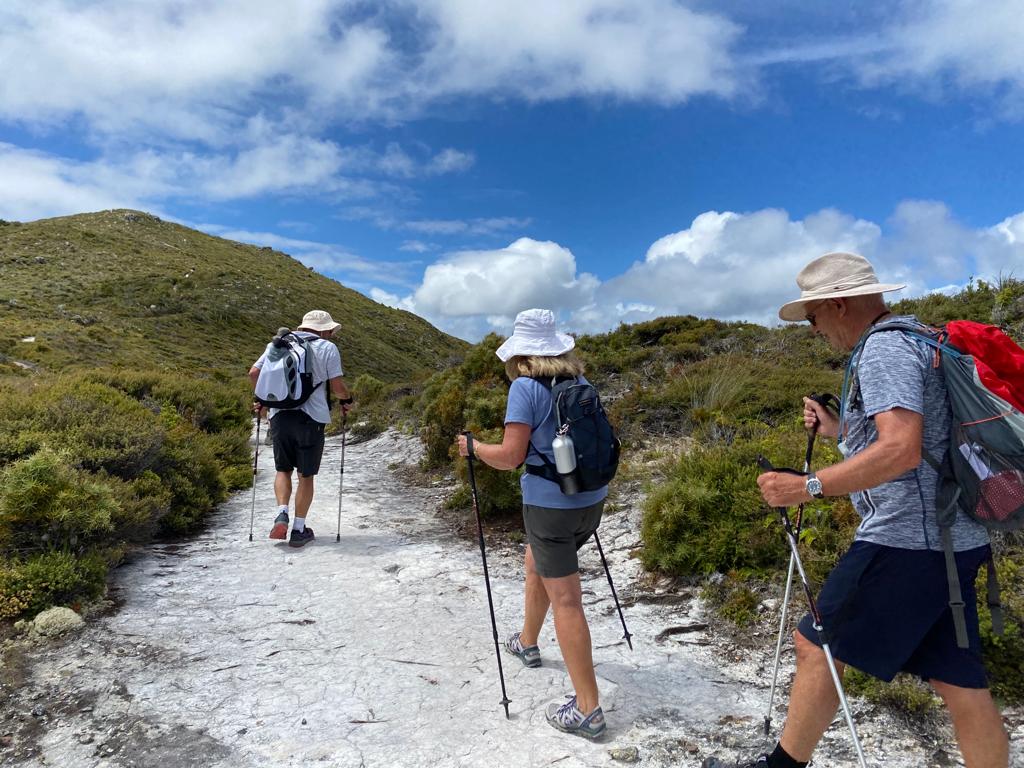
Level 3 – Moderate
The fun really starts on Level 3 hiking trails for us at Walking Legends. We love Level 3 and Level 4 trails so much that we’ve built our itineraries around them as the ‘main event.’ A moderate hiking trail requires specialist outdoor footwear, like a hiking boot or a hiking shoe. Sports shoes, running shoes or cross-trainers don’t have enough grip for the slippery, clay-based soils in New Zealand.
What Is a Level 3 Trail Like in New Zealand?
A Level 3 trail will have reasonable elevation gain or loss of anywhere between 300m and 600m in altitude. We hike up valleys, over ridges and saddles, or even up minor peaks in the range of 900m to 1,200 metres above sea level. There’ll be lots of stairs to negotiate, tree roots to climb over and patches of rocky, uneven ground. After periods of heavy rain there’s likely to be areas of muddy ground, but major river or stream crossings are still likely to be bridged.
The trail will still be well-marked. Finding the orange markers may require slightly more attention than on easier trails. The markers can sometimes be obscured by over-growth. Usually you’ll be walking within ear-shot or eyesight of our guides or one of the other walkers in the group so this isn’t a problem. Our guides will make sure you’re properly briefed on where to turn, where to wait or how far it is until our next rendezvous point.
We’re starting to move into longer distances in Level 3. You can expect to be walking around 4 – 5 hours, which includes stops for meals and rehydration and anywhere between 8 and 12 kilometres. On a Level 3 trail you’ll experience periods of heart-pumping activity as we ascend, but not for long, as the downhills are usually just around the corner.
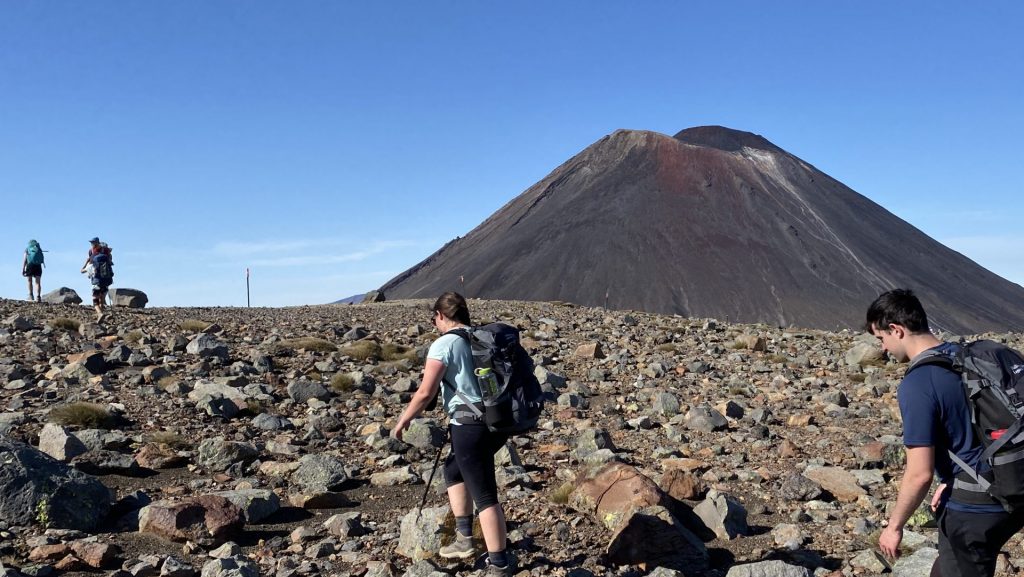
Level 4 – Moderate to Hard
Any walk that sits in the ‘moderate to hard’ category is everything that a ‘moderate’ walk is, plus slightly more. Expect gradients that are a few degrees steeper, elevation gains that are just a little higher and maybe a few terrain features that require some technical skill.
What Is A Moderate to Hard Hiking Track in New Zealand?
For example, the Pinnacles Track in the Kauaeranga Valley is a solidly ‘moderate’ grade trail for the majority of its’ length. Except for the final 30 minute section from the Pinnacles Hut up to the peak proper. This final section includes a steep steel staircase, enclosed with balustrading. There’s a network of ladder rungs attached to some really big boulders that help get us up between them. We usually complete this walk on Day 2 of the Coromandel Explorer guided hike.
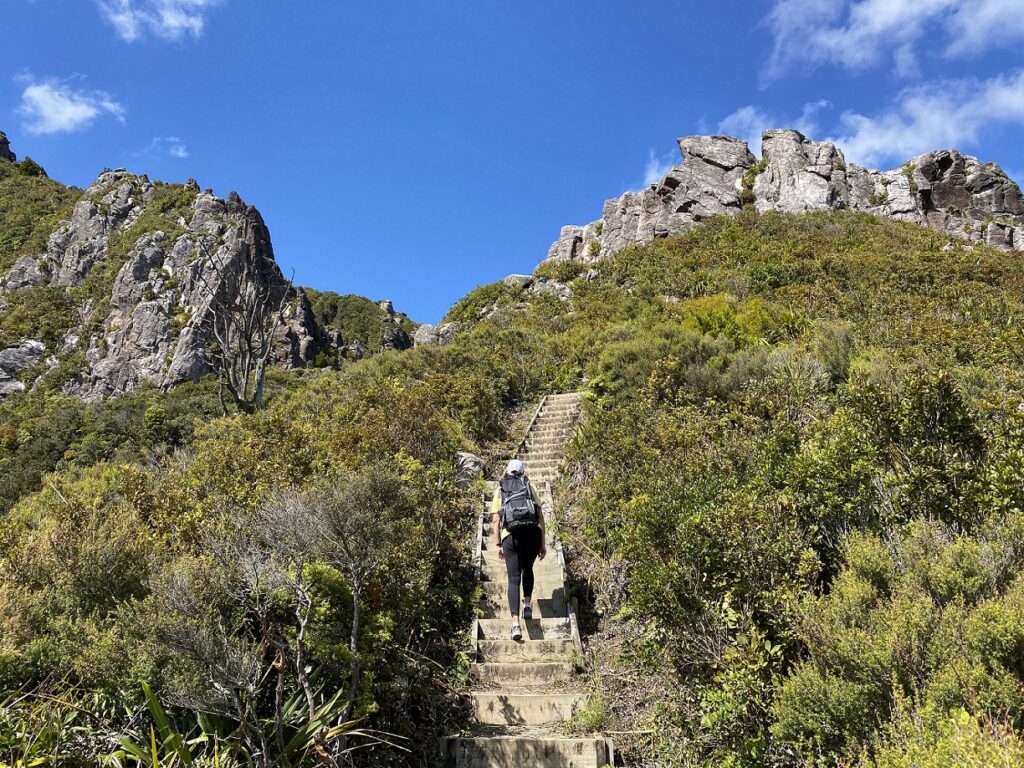
The Tongariro Alpine Crossing is a Moderate to Hard Hiking Trail in New Zealand
Another example is on the Tongariro Alpine Crossing .This track is 20.2km and one of the longest guided hikes we do in the North Island. It’s not just the distance that pushes it up into the Level 4 category. It’s also a unique feature of the track called the Scree Slope. We do the Tongariro Alpine Crossing on Day 2 of the 4-day Tongariro Hiking Tour. Once we’ve reached the main summit of the Alpine Crossing track we’ll find ourselves at Red Crater looking down on the beautiful Emerald Lakes.
How To Safely Descend The Scree Slope on the Tongariro Alpine Crossing in New Zealand
To get from Red Crater down to Emerald Lakes we must negotiate a roughly 200 metre stretch of loose scree and sand. Take things slowly and turn your feet sideways as though you were descending a regular set of stairs. Stay alert to other hikers nearby who may be causing loose material to roll down the slope against your feet. Remain as far away from other walkers as you can. That’s a little hard to do sometimes with the numbers of walkers that tackle this track daily, .
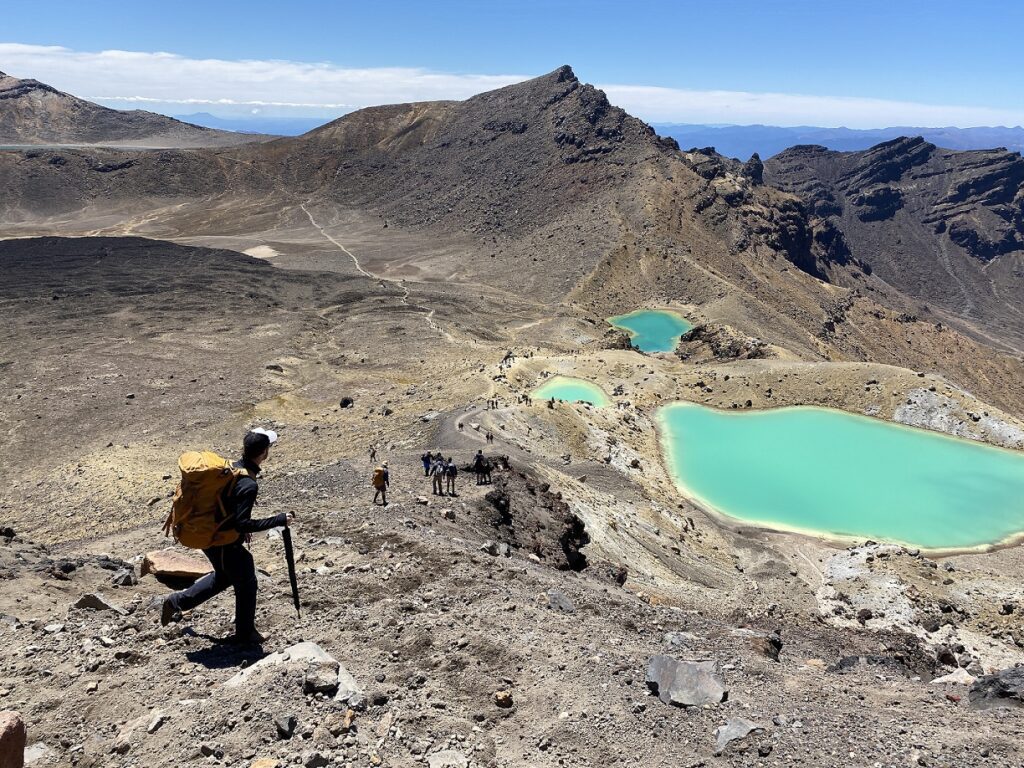
Overall, a Walking Legends itinerary will only include short sections of Level 4 trail. The rest will be comfortably within the Level 3 category. Every night over dinner, your guides give you a thorough safety briefing on what to expect the next day. You can ask any questions or whether you should attempt the walk. Our guides have done a few walks with you by this time, as a result they’ll have a good read on where you’re at. Our walkers, who are in their 50’s, 60’s and 70’s, manage these trails beautifully. The excitement and sense of achievement at the end is an absolute fizzer for us all!
Level 5 – Hard
Level 5 trails are advanced, backcountry tramping trails. We don’t do any Level 5 graded trails in our North Island guided walk itineraries. Level 5 trails are largely unmarked, requiring you to have great maps and experience with using only a compass. You need to have solid backcountry bushcraft skills for Level 5 trails in New Zealand. We highly recommend you go with a backcountry guide, because our outdoor environment is unique. Local knowledge is invaluable when it comes to our extreme weather and steep terrain.
Got More Questions?
Lastly, our friendly team are always on hand to help answer any deeper enquiries you might have. We’ve been hiking North Island trails for over 20 years and our team have a wealth of experience to draw from. Give us a call or send us an email if you’d like to check whether your particular fitness level or physical ability will suit a Walking Legends guided walk.
Email us: [email protected]
Call us: 64 7 533 3157 (international)
NZ Freephone 0800 925 569 (0800 WALK NZ)
AUS Freephone 1800 646 584